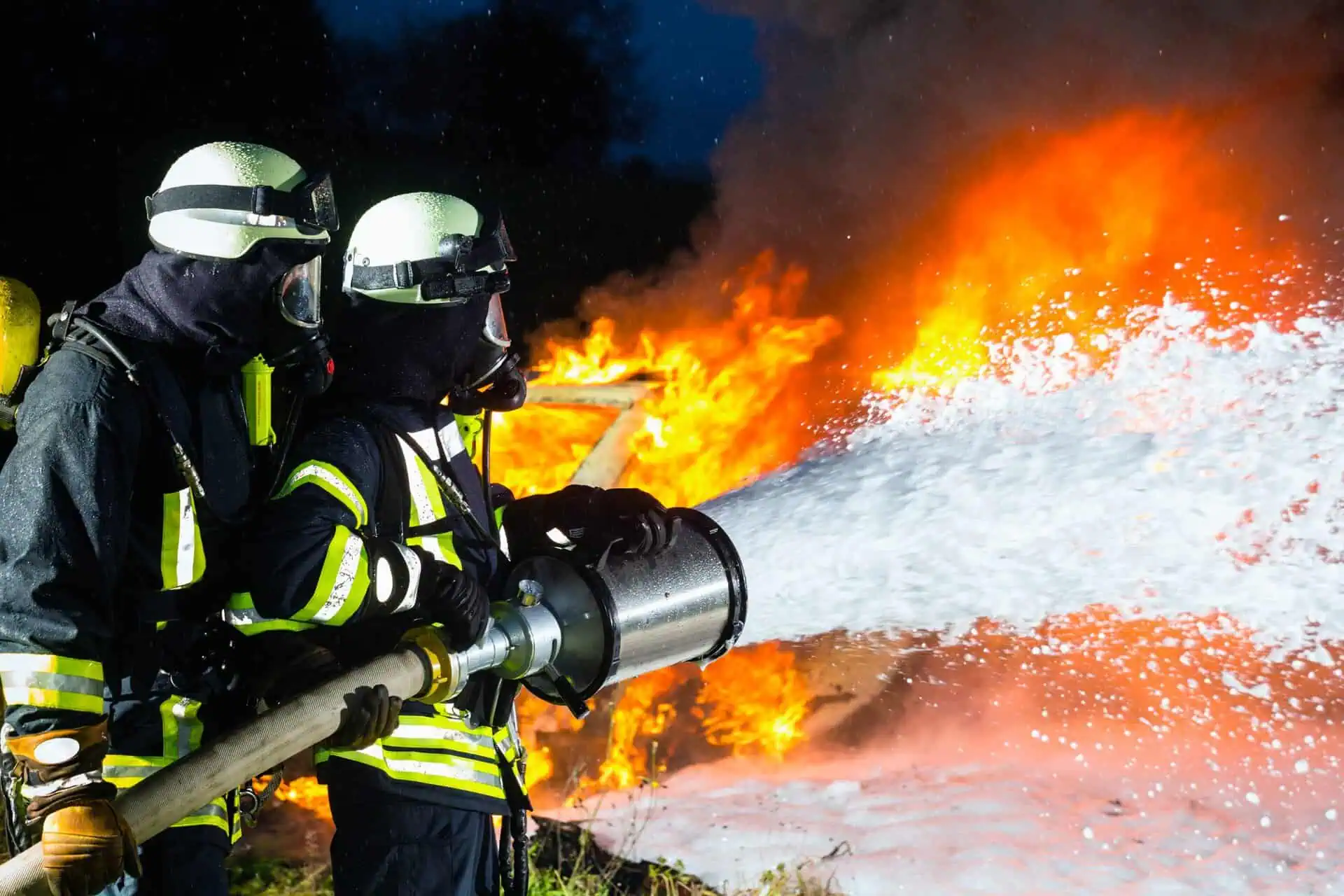What is the Average Payout for the AFFF Lawsuit
- Last Updated: July 14th, 2025

Attorney Jessica Paluch-Hoerman, founder of TruLaw, has over 28 years of experience as a personal injury and mass tort attorney, and previously worked as an international tax attorney at Deloitte. Jessie collaborates with attorneys nationwide — enabling her to share reliable, up-to-date legal information with our readers.
Legally Reviewed
This article has been written and reviewed for legal accuracy and clarity by the team of writers and legal experts at TruLaw and is as accurate as possible. This content should not be taken as legal advice from an attorney. If you would like to learn more about our owner and experienced injury lawyer, Jessie Paluch, you can do so here.
Fact-Checked
TruLaw does everything possible to make sure the information in this article is up to date and accurate. If you need specific legal advice about your case, contact us by using the chat on the bottom of this page. This article should not be taken as advice from an attorney.
Key takeaways:
- The average payout for AFFF lawsuits varies depending on factors such as the timeline and extent of PFAS exposure and serious health conditions developed after being subjected to the exposure.
- Determining eligibility for an AFFF firefighting foam lawsuit involves meeting criteria such as occupational exposure, related health conditions, and the ability to identify specific products, with attorneys helping assess individual cases.
- Expected future trends in AFFF litigation include increased cases filed, potentially higher individual settlements, and regulatory changes that may impact manufacturer liability and lawsuit outcomes.
Overview of Average Payout for the AFFF Lawsuit
On this page, we’ll discuss an overview of an average payout for the AFFF lawsuit, financial implications of an AFFF lawsuit settlements, how to determine eligibility for an AFFF lawsuit, and much more.
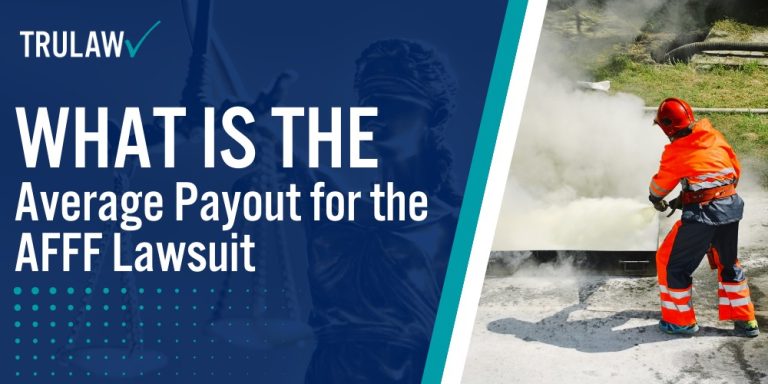
Introduction to Average Payout for the AFFF Lawsuit
Factors that may influence settlement amounts include:
- Severity of Health Issues: Settlements are generally higher for plaintiffs with severe health conditions linked to PFAS exposure, such as cancer.
- Extent of Environmental Damage: Significant contamination can lead to larger payouts to fund cleanup efforts.
- Legal Precedents: Past settlement amounts in similar cases set a benchmark.
- Number of Claims: The total number of claims filed can impact the individual payout if a global settlement is reached.
If you are a veteran or firefighter who used AFFF and has since been diagnosed with cancer or other serious illnesses, you may have a case in the AFFF lawsuit.
Contact TruLaw using the chat on this page for an instant case evaluation to see if you are eligible to seek compensation in the AFFF litigation.
Table of Contents
AFFF Firefighting Foam and Related Lawsuits
Aqueous Film-Forming Foam (AFFF) has been widely used in firefighting for its effectiveness.
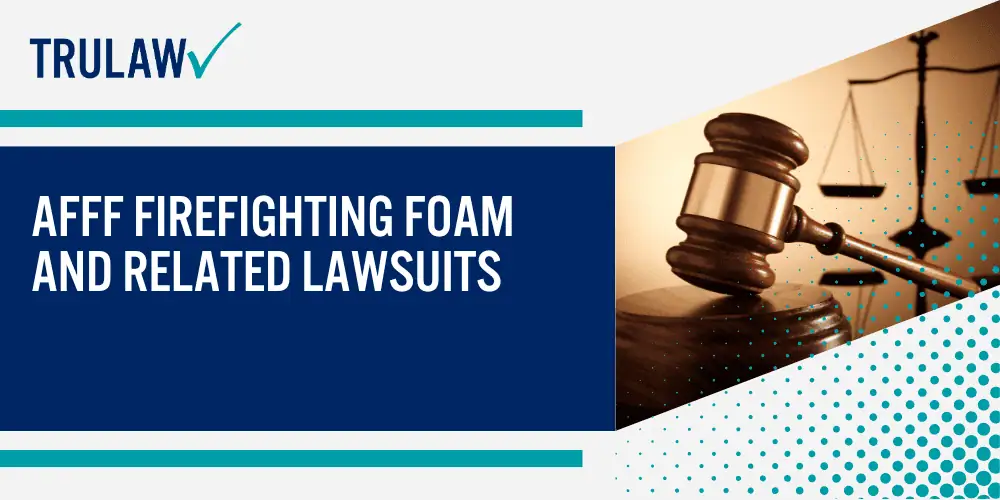
However, its ingredients raise concerns regarding health and environmental risks, spurring numerous AFFF firefighting foam lawsuits.
What is AFFF? Basics and Usage in Firefighting
AFFF is a fire suppressant foam designed to extinguish flammable liquid fires.
It works by creating a film that cools the fuel and smothers the flames.
Commonly used by the military, airports, and firefighters. AFFF firefighting foam is known for its efficiency in handling difficult fires.
Key points about AFFF firefighting foam include, but are not limited to:
- Effective against liquid-based fires.
- Uses perfluoroalkyl and polyfluoroalkyl substances.
- Deployed in high-risk areas like airports and military bases.
- Standard equipment for many fire departments.
Its effectiveness has made it a staple in emergencies, yet its chemical components have sparked significant legal and environmental issues.
Health and Environmental Risks Associated with AFFF
AFFF contains PFAS chemicals known for their persistence in the environment and potential health risks.
Exposure to PFAS has been linked to various health issues, leading to AFFF cancer lawsuits.
Major concerns regarding AFFF health and environmental risks include, but are not limited to:
- PFAS contamination in water supplies.
- Increased cancer risk among exposed populations.
- Long-term environmental impact, as PFAS are not easily broken down.
- Legal actions seek to address the harm caused by these chemicals.
The extensive use of AFFF firefighting foam has made understanding its risks and the resulting litigation essential for affected communities and professionals.
AFFF foam lawsuits seek to hold manufacturers accountable for these health and environmental damages.
For more details, refer to 3M’s involvement in the lawsuits and ongoing litigations.
Legal Landscape of AFFF Lawsuits
Firefighting foam litigation has developed considerably over recent years, focusing on litigation involving aqueous film-forming foam (AFFF).
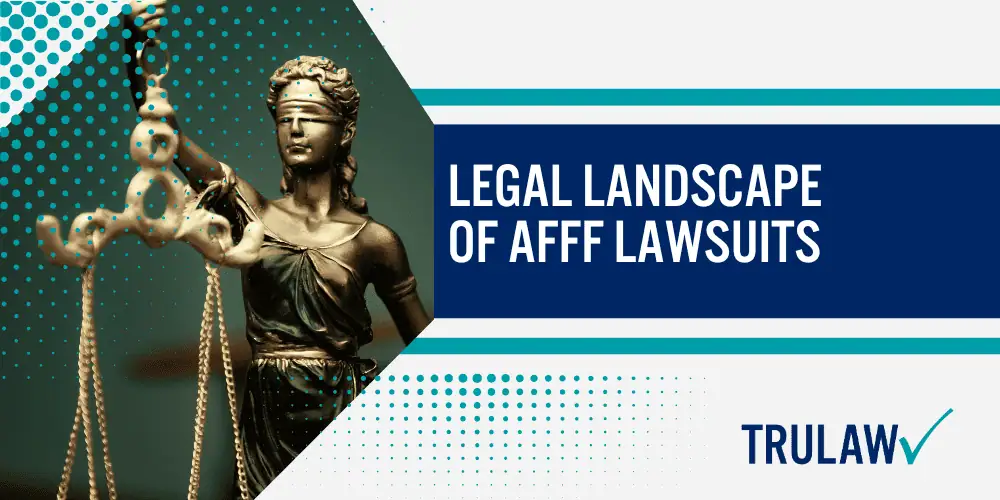
Understanding the history and background of these lawsuits and identifying major players and key lawsuits provides insight into the ongoing legal landscape.
History and Background of AFFF Litigation
AFFF firefighting foam has been used for decades, particularly by the military, airports, and local fire departments.
Initially hailed for its effectiveness in extinguishing flammable liquid fires, concerns arose when it was discovered that per and polyfluoroalkyl substances (PFAS) in AFFF are persistent and harmful to the environment and human health.
Litigation began as affected communities, states, and environmental groups sued manufacturers.
Notably, Multidistrict Litigation (MDL), known as the AFFF MDL, consolidated many of these cases to streamline proceedings and handle shared legal questions.
Key milestones in the history of AFFF litigation include:
- Initiation of lawsuits in the early 2000s.
- Formation of MDL 2873 in 2018.
- Ongoing class action lawsuits addressing environmental and health impact claims.
- Legal battles over cleanup costs and damages.
Major Players and Key Lawsuits Involving AFFF
Several key players dominate the AFFF litigation landscape.
Here are some of the most prominent entities involved in these lawsuits:
- 3M: Major manufacturer named in numerous lawsuits.
- DuPont: Heavily involved due to its production of PFAS chemicals.
- US Department of Defense: Faces significant scrutiny for its historical use of AFFF.
Notable Developments in the AFFF Lawsuit
AFFF lawsuits have seen substantial progress recently, impacting various stakeholders.
These cases are drawing attention due to the serious environmental and health concerns of PFAS contamination.
Significant lawsuits involving AFFF include, but are not limited to:
- State of Connecticut against 28 chemical manufacturers for PFAS contamination.
- Maryland Attorney General suing 3M and DuPont over environmental damage caused by AFFF.
- Centralized AFFF litigation (MDL 2873): Central hub for federal AFFF firefighting foam cases.
These lawsuits focus on environmental impacts, public health concerns, and the financial costs associated with PFAS cleanup.
Consequently, the outcomes of these cases will significantly influence regulatory standards and future manufacturing practices.
Understanding these entities and lawsuits is crucial for comprehending the ongoing battle over environmental accountability and corporate responsibility in the context of firefighting foam.
Factors Influencing the Average Payout for the AFFF Lawsuit
Several factors significantly shape the financial compensation awarded in AFFF lawsuits.
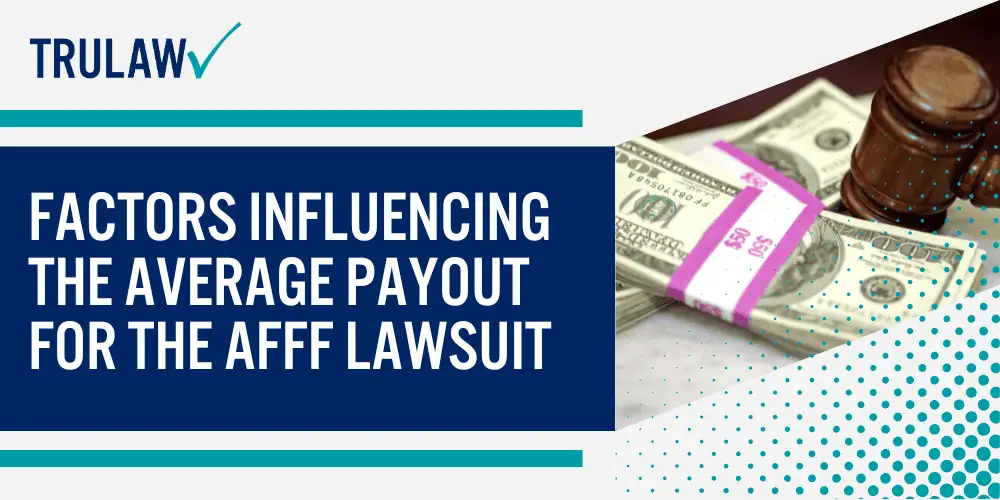
These include the severity of the plaintiffs’ health issues and the legal environment in various jurisdictions.
Severity of Health Impacts and Their Role in Payouts
Health conditions linked to AFFF exposure play a major role in determining settlement amounts.
Conditions such as cancer, particularly those strongly associated with AFFF, typically result in higher payouts.
Key factors here include, but are not limited to:
- Type and Stage of Cancer: More advanced stages of cancer may warrant higher compensation.
- Medical Expenses: Costs for treatments, surgeries, and ongoing care are critical.
- Lost Wages: Time off work due to illness impacts the settlement.
- Emotional Distress: Non-economic losses, like stress from dealing with chronic illness, are also considered.
Detailed medical documentation helps substantiate claims, influencing the final payout.
Jurisdictional Differences and Legal Precedents
Legal precedents in different states impact AFFF lawsuit settlement amounts.
Some jurisdictions have a history of higher payouts for similar cases, affecting expectations and outcomes.
Important considerations in jurisdictional differences and legal precedents include, but are not limited to:
- State Laws: Different states have various regulations regarding evidence and compensation caps.
- Court Rulings: Previous court decisions in a jurisdiction can set expectations for current cases.
- Attorney Expertise: Lawyers familiar with local laws can navigate cases more effectively, impacting outcomes.
- Jury Tendencies: Some regions may have juries that lean towards higher or lower awards.
Economic losses, medical expenses, and lost wages can vary in importance depending on the jurisdiction, affecting the overall compensation package.
Case Studies: Average Payout for the AFFF Lawsuit
This section delves into notable settlements in AFFF lawsuits and contrasts the average payouts between class action and individual lawsuits.
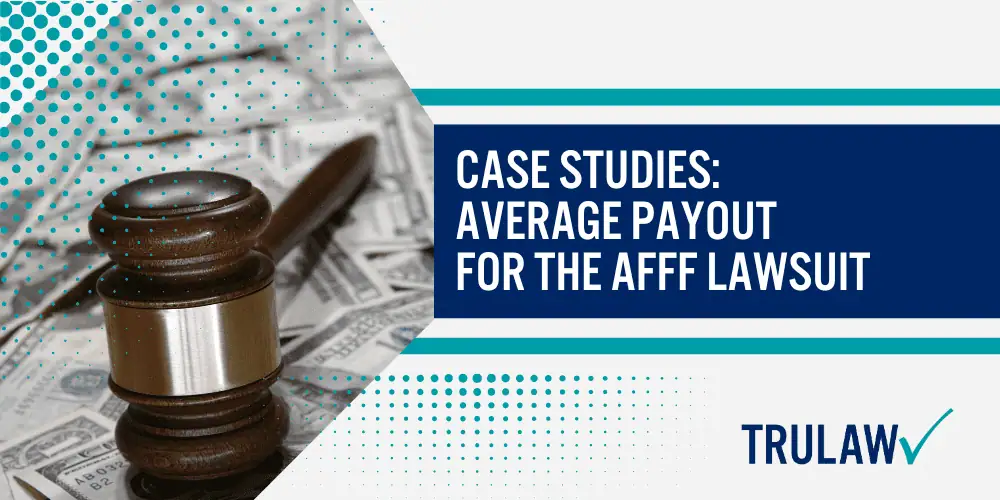
Significant trends and patterns in these cases are highlighted.
Notable Settlements and Their Average Payouts
Notable settlements in AFFF lawsuits have varied based on the severity of contamination and harm caused.
Here are some examples of significant settlements and their average payouts:
- 3M Settlement: In one case, 3M agreed to settle for approximately $850 million to resolve claims regarding water contamination.
- Dupont Cases: Settlements involving Dupont have reported payouts averaging between 50,000𝑡𝑜50,000to100,000 per claimant, depending on firefighting foam exposure and damage.
- Firefighting Foam Settlements: Various firefighting foam settlements have seen payouts range from 10,000𝑡𝑜10,000to200,000 per individual, reflecting the diversity in plaintiff circumstances.
- Global Settlement Deals: Some global settlement deals have emerged, offering multi-million dollar resolutions covering broader groups of claimants.
These figures highlight the financial responses to damages caused by AFFF, emphasizing the legal precedent in these environmental contamination cases.
Comparing Class Action vs. Individual AFFF Lawsuit Payouts
Class action lawsuits and individual lawsuits offer different avenues for pursuing compensation in AFFF cases.
Here are the key differences between these two approaches:
- AFFF Firefighting Foam Manufacturers: While a settlement agreement has not been reached yet in the AFFF MDL, which has expanded to include nearly 10,000 individuals seeking compensation against AFFF firefighting foam manufacturers.
- Complexity and Duration: Class actions may be simplified in terms of process but can be stretched over longer periods. Individual claims might resolve quicker but involve more intensive litigation.
- Negotiation Leverage: Individual plaintiffs may have more room to negotiate higher settlements directly, contrasting with the shared negotiation power of class actions.
These comparisons illustrate the strategic decisions plaintiffs face in seeking compensation for AFFF-related damages.
How to Determine Eligibility for an AFFF Lawsuit
The AFFF MDL is steadily approaching over 10,000 pending claims. It is important to note that the qualification criteria may evolve as the MDL progresses. Contact TruLaw using the chat on this page to determine your eligibility to seek compensation in the AFFF MDL today.
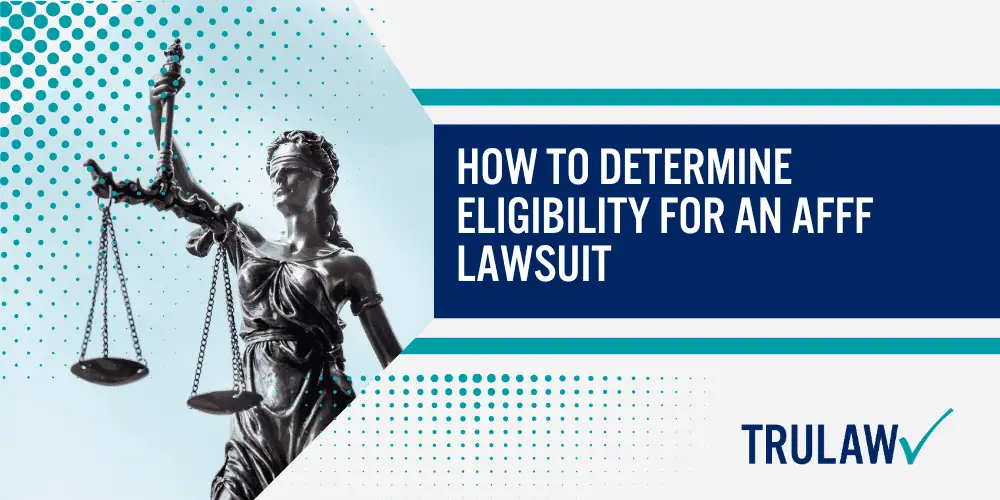
Knowing whether you qualify requires careful consideration of various factors affecting you or your family.
Criteria for Filing an AFFF Lawsuit
To be eligible to file an AFFF lawsuit, individuals should meet several criteria based on their experiences and the impact of AFFF.
Key factors for filing an AFFF lawsuit include, but are not limited to:
- Occupational Exposure: Were you exposed to AFFF due to your job? This often includes military personnel, firefighters, and airport workers.
- Health Conditions: Do you or a family member suffer from health issues linked to AFFF, such as certain types of cancer?
- Timing of Exposure: Is there documented evidence of your exposure timeline matching with known hazardous periods of AFFF use?
- Product Identification: Can you identify the specific AFFF products or manufacturers responsible for your exposure?
These criteria help in verifying whether an individual’s circumstances align with the requirements for initiating a firefighting foam lawsuit.
Steps to Take When Considering Legal Action
If you believe you have been harmed by AFFF exposure, it’s essential to understand the necessary steps for legal recourse.
Taking the right actions early can significantly impact the success of your case.
When contemplating legal action for AFFF exposure, it is important to follow these steps:
- Seek Medical Records: Obtain medical documentation that connects your health condition to AFFF exposure. This will be crucial for building a strong case.
- Consult a Firefighting Foam Attorney: Engage with a specialized attorney who has experience with AFFF exposure lawsuits. They can provide tailored legal advice.
- Gather Evidence: Collect any evidence of your exposure, such as employment records, military service documents, and any direct contact with AFFF.
- File an AFFF Lawsuit: With your attorney’s guidance, formally file the AFFF firefighting foam MDL lawsuit against the manufacturers responsible for the hazardous AFFF products.
These steps ensure a thorough approach when bringing legal action regarding AFFF-related cancer and other health issues.
Financial Implications of AFFF Lawsuit Settlements
These settlements involve financial compensation for various economic losses.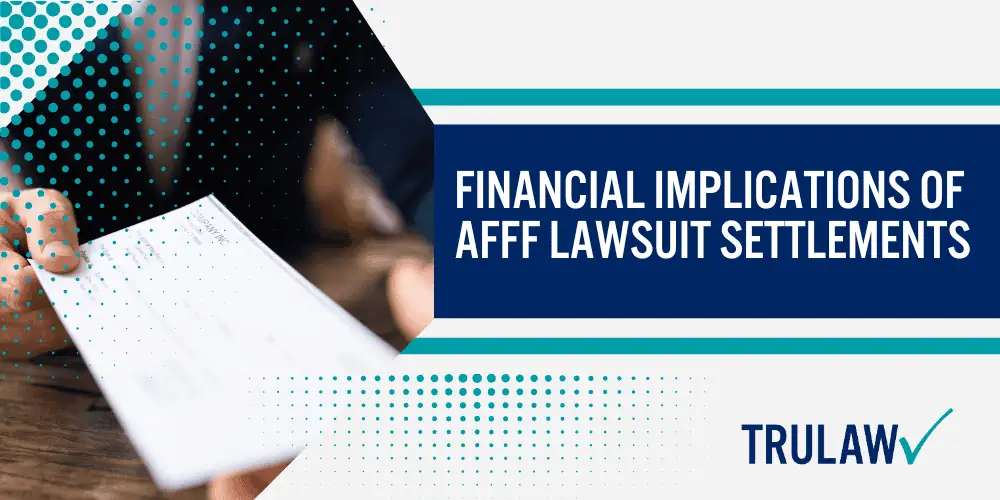
The focus is on medical expenses, lost wages, and long-term impacts on affected individuals.
Breakdown of Compensation Categories in AFFF Settlements
AFFF settlements typically include several compensation categories.
Key areas that are often covered:
- Medical Expenses: Costs related to diagnosing and treating ailments caused by PFAS exposure.
- Lost Wages: Compensation for work hours missed due to illness or medical appointments.
- Property Damage: Financial help for cleaning or replacing contaminated property.
- Pain and Suffering: Non-economic damages for emotional distress and reduced quality of life.
- Legal Fees: Coverage for attorney and court costs associated with the lawsuit.
These categories ensure comprehensive financial relief for affected individuals.
Long-term Financial Impacts on Affected Individuals
Long-term impacts include ongoing medical expenses and associated treatments.
Persistent health issues related to PFAS exposure may lead to continuous healthcare costs, including surveillance and intervention.
Affected individuals might also face reduced earning capacity, impacting their economic stability.
Additionally, potential costs for emotional and psychological support services reflect the broader implications for mental health.
These financial burdens underscore the need for substantial and fair settlement amounts.
Understanding the full spectrum of financial implications helps highlight the importance of adequate compensation for both immediate and prolonged effects of PFAS exposure.
Legal Representation and Resources for AFFF Lawsuits
Selecting the right legal representation and utilizing available resources can significantly impact the outcome of an AFFF lawsuit.
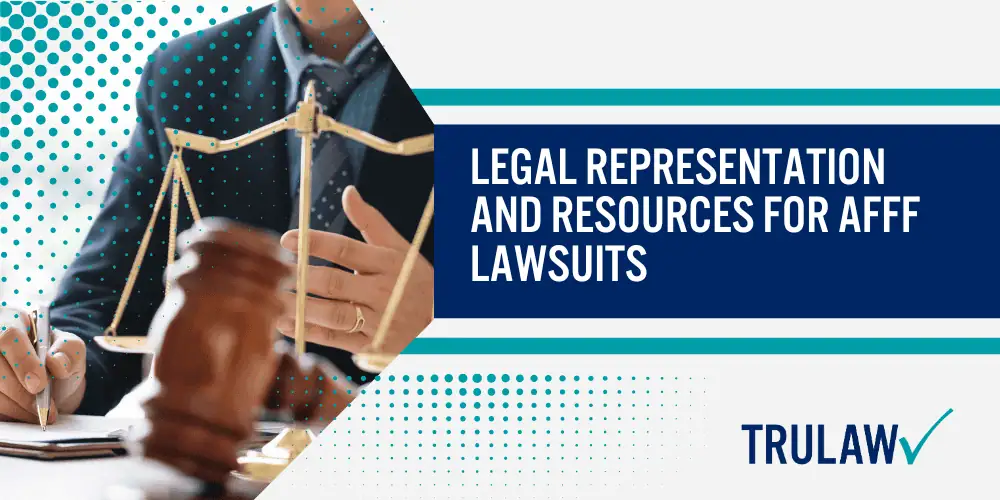
Therefore, plaintiffs must understand how to find qualified lawyers and access relevant support services.
Finding the Right Lawyer for an AFFF Case
Choosing an experienced lawyer is vital for individuals looking to file an AFFF lawsuit.
When selecting an AFFF lawyer, consider the following:
- Experience: Look for lawyers with a proven track record in environmental litigation and cases involving AFFF.
- Reputation: Research reviews and testimonials from previous clients to gauge reliability and success rates.
- Resources: Ensure the law firm has the necessary resources to handle chemical exposure lawsuits, including scientific experts and investigators.
- No Upfront Fees: Many AFFF lawyers work on a contingency fee basis, meaning they only get paid if you win the case. This can lessen the financial burden on plaintiffs.
- Consultations: Initial consultations should be free. This allows you to discuss your case and evaluate the lawyer’s suitability without any obligation.
Resources and Support for AFFF Lawsuit Plaintiffs
Various resources and support systems are available to assist plaintiffs in AFFF lawsuits.
Supportive resources include:
- Educational Material: Documents like the PFAS information by Vermont DEC offer insights into ongoing lawsuits, informing plaintiffs about their rights and the legal process.
- Community Support Groups: Joining groups with fellow plaintiffs can provide emotional support and share useful advice on managing the legal journey.
By leveraging these resources, plaintiffs can better navigate their legal paths and improve their chances of a favorable outcome.
Future Outlook on AFFF Lawsuits and Settlements
As awareness of PFAS contamination grows, the legal landscape is set to evolve.
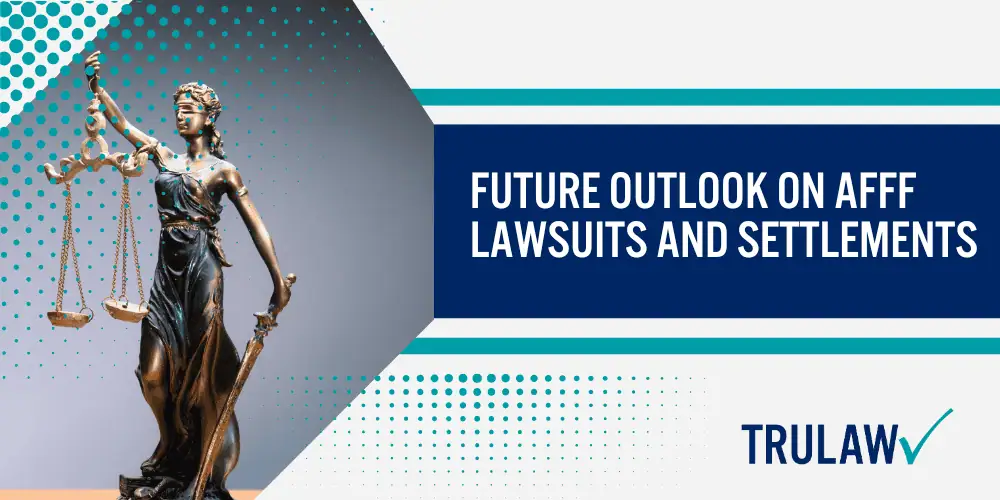
Increasing litigation and potential regulatory changes will shape future AFFF litigation and settlement trends.
Expected Trends in AFFF Litigation and Payouts
As awareness of PFAS contamination grows, the volume of AFFF litigation is expected to increase with it.
These actions put additional pressure on manufacturers of PFAS and AFFF chemicals to address contamination issues and potentially expedite settlement negotiations.
As the number of lawsuits rises, courts may see higher settlement amounts and more class action suits.
Several trends to watch in AFFF litigation and payouts include, but are not limited to:
- Increase in Class Action Lawsuits: More plaintiffs banding together.
- Higher Settlement Amounts: Larger payouts as evidence mounts.
- Focus on Health Impact: Emphasis on long-term health consequences
- Geographical Expansion: More lawsuits filed across various states.
- Corporate Accountability: Stricter scrutiny of manufacturers.
Potential Changes in Regulations and Their Impact on Payouts
Future regulations could greatly affect AFFF settlements.
Government actions may force companies to pay more in damages and settlements.
Legislation focusing on PFAS limits in water supplies and stricter oversight on production will likely increase.
Here are some potential regulatory changes and their implications:
- Stricter PFAS Limits: Tighter regulations on PFAS levels.
- Increased Manufacturer Liability: Legal requirements for better safety measures.
- Enhanced Testing and Monitoring: More rigorous environmental impact tests.
- Legislation for Cleanup Costs: Laws forcing manufacturers to pay more for cleanup.
- Public Pressure: Growing demand for accountability from companies.
Regulatory changes could significantly heighten awareness, compensation patterns, and corporate behavior, impacting future litigation cases surrounding AFFF and PFAS contamination.
Tru Law: Maximizing Your Payout for the AFFF Lawsuit
Tru Law offers expert assistance to maximize your compensation in the AFFF lawsuit.
Their skilled attorneys guide you through the legal processes.
How Tru Law Can Help You File an AFFF Lawsuit
Tru Law’s experienced firefighting foam attorneys provide several vital services to streamline your case:
- Case Evaluation: They assess the impact of AFFF exposure on health, evaluating eligibility for compensation.
- Evidence Collection: The team gathers crucial documents and witness statements necessary for a solid case.
- Legal Representation: Tru Law’s chemical exposure attorneys will advocate for you in settlement negotiations and court proceedings.
- Compensation Maximization: They aim to secure the highest possible payout, considering medical expenses, lost wages, and emotional distress.
- Client Support: Offering guidance throughout, they ensure you understand each step of the legal process.
By focusing on these areas, Tru Law enhances your chances of a successful claim.
AFFF Lawsuit Frequently Asked Questions
-
The timeline for an AFFF lawsuit settlement payout can vary due to the challenges in these cases.
Generally, it can take several months to a few years for cases to resolve.
-
To qualify for the AFFF lawsuit, individuals must demonstrate exposure to AFFF and subsequent health issues.
This includes showing a connection between exposure and illnesses like cancer or other serious conditions.
-
Settlement amounts are determined based on several factors, including the severity of the health impact, the duration of exposure, and medical expenses incurred.
Factors also consider the plaintiff’s personal suffering and loss of income.
-
Many AFFF firefighting foam cancer lawsuits have been centralized by the Judicial Panel on Multidistrict Litigation in the District of South Carolina.
These cases involve common legal questions and facts, ensuring efficient handling by a single court.
-
Veterans exposed to AFFF during their service may qualify for VA disability benefits.
They need to provide evidence of exposure and medical documentation linking their health conditions to AFFF.
-
Compensation amounts for AFFF exposure lawsuit settlements can vary widely.
While specific figures are not always disclosed, settlements can range from a few thousand dollars to significant sums, depending on the facts of the case and the severity of the harm.

Managing Attorney & Owner
With over 25 years of legal experience, Jessica Paluch-Hoerman is an Illinois lawyer, a CPA, and a mother of three. She spent the first decade of her career working as an international tax attorney at Deloitte.
In 2009, Jessie co-founded her own law firm with her husband – which has scaled to over 30 employees since its conception.
In 2016, Jessie founded TruLaw, which allows her to collaborate with attorneys and legal experts across the United States on a daily basis. This hypervaluable network of experts is what enables her to share the most reliable, accurate, and up-to-date legal information with our readers!
Additional AFFF Lawsuit resources on our website:
Here, at TruLaw, we’re committed to helping victims get the justice they deserve.
Alongside our partner law firms, we have successfully collected over $3 Billion in verdicts and settlements on behalf of injured individuals.
Would you like our help?
At TruLaw, we fiercely combat corporations that endanger individuals’ well-being. If you’ve suffered injuries and believe these well-funded entities should be held accountable, we’re here for you.
With TruLaw, you gain access to successful and seasoned lawyers who maximize your chances of success. Our lawyers invest in you—they do not receive a dime until your lawsuit reaches a successful resolution!
AFFF Lawsuit claims are being filed against manufacturers of aqueous film-forming foam (AFFF), commonly used in firefighting.
Claims allege that companies such as 3M, DuPont, and Tyco Fire Products failed to adequately warn users about the potential dangers of AFFF exposure — including increased risks of various cancers and diseases.
Depo Provera Lawsuit claims are being filed by individuals who allege they developed meningioma (a type of brain tumor) after receiving Depo-Provera birth control injections.
A 2024 study found that women using Depo-Provera for at least 1 year are five times more likely to develop meningioma brain tumors compared to those not using the drug.
Suboxone Tooth Decay Lawsuit claims are being filed against Indivior, the manufacturer of Suboxone, a medication used to treat opioid addiction.
Claims allege that Indivior failed to adequately warn users about the potential dangers of severe tooth decay and dental injuries associated with Suboxone’s sublingual film version.
Social Media Harm Lawsuits are being filed against social media companies for allegedly causing mental health issues in children and teens.
Claims allege that companies like Meta, Google, ByteDance, and Snap designed addictive platforms that led to anxiety, depression, and other mental health issues without adequately warning users or parents.
Transvaginal Mesh Lawsuits are being filed against manufacturers of transvaginal mesh products used to treat pelvic organ prolapse (POP) and stress urinary incontinence (SUI).
Claims allege that companies like Ethicon, C.R. Bard, and Boston Scientific failed to adequately warn about potential dangers — including erosion, pain, and infection.
Bair Hugger Warming Blanket Lawsuits involve claims against 3M — alleging their surgical warming blankets caused severe infections and complications (particularly in hip and knee replacement surgeries).
Plaintiffs claim 3M failed to warn about potential risks — despite knowing about increased risk of deep joint infections since 2011.
Baby Formula NEC Lawsuit claims are being filed against manufacturers of cow’s milk-based baby formula products.
Claims allege that companies like Abbott Laboratories (Similac) and Mead Johnson & Company (Enfamil) failed to warn about the increased risk of necrotizing enterocolitis (NEC) in premature infants.
Here, at TruLaw, we’re committed to helping victims get the justice they deserve.
Alongside our partner law firms, we have successfully collected over $3 Billion in verdicts and settlements on behalf of injured individuals.
Would you like our help?
